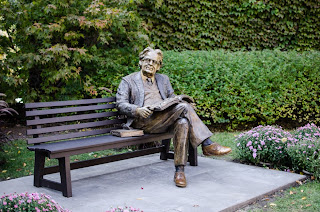As the graduates of Rugby spread throughout the empire, they took their game with them. In the 1870s, a hybrid form of Rugby became popular in Montreal among the local garrison and students at McGill University. In 1874, a key year in this story, McGill was invited to play a game of “football” with Harvard University. Upon arrival, both teams were surprised to learn that they understood “football” differently, with the Harvard squad playing the kicking version, and McGill playing rugby football. They resolved to play two games, one under the McGill rules and another under Harvard’s rules. The rugby game was a hit with Harvard, and they immediately persuaded the other Ivy League schools to take it on.
On both
sides of the border, Canadian and American clubs began adapting the game to
their fancy. They mixed and swapped rules as they played each other, incorporating
what they liked and learning from each other. The Americans began to develop quickly
in the 1800s, making the game more recognizable to the football we see today. In
1905, Canada caught up with the publication of the Burnside Rules, put out by
the Ontario Rugby Football Union. They dictated 12 men per side, the “snap back”
from the scrimmage line to begin play, and the requirement to make 10 yards in
3 downs or turn over possession. Surprisingly, the forward pass was not allowed
until 1931.
In 1909, Lord Earl Grey, having already left his mark on the world of tea, further immortalized his name with a new trophy. Lord Grey’s Cup was to be awarded annually to the champion football team in Canada, and it has been a Canadian institution ever since. As the game developed in popularity across Canada, it came to be praised as a symbol of national unity. In 1962, Parliament decreed that all Canadian television should air the game to make it available to viewers in every region.
I want to close by sharing a description of one play that captures why the CFL is great fun to watch. This play happened on July 1, 2012, in the Argos vs. Eskimos game in Edmonton. With 2:45 on the clock in the second quarter, the Toronto center snaps the ball to #15 Ricky Ray, QB for the Argos. Ricky drops back as his receivers sprint their routes; his eyes scan the field for a split second; he sees #2 Chad Owens open and throws a bullet pass, which is so low that Owens actually to has catch the ball and roll on the ground. Owens picks himself up in a hornet’s nest of four defensive backs and begins to sprint toward the Argos endzone. He jukes left around one defender, evades another, stuffs his tattooed arm in the face of a third, and runs all the way to the 5-yard line, finally pushed out of bounds by a desperate Eskimos defender. It was a brilliant display of speed and athleticism (1). For a full season of such performance, Chad Owens was named the league’s Most Outstanding Player this past week.
 |
| Chad Owens in action against the Edmonton Eskimos (Photo Courtesy of Nathan Denette / The Canadian Press) |
Tomorrow,
the Argonauts crew goes into battle against the Calgary Stampeders in the 100th
Grey Cup game (2). I invite all readers to join me in celebrating this great
Canadian tradition!
(1) You can watch
the above play on the CFL website. Fast forward to 02:32.
(2) The Grey
Cup was not played from 1916-18 because of World War I, and a dispute over
rules cancelled the game in 1919.
Source Consulted: The Canadian Encyclopedia - "Football," "The Grey Cup"
http://www.thecanadianencyclopedia.com
Source Consulted: The Canadian Encyclopedia - "Football," "The Grey Cup"
http://www.thecanadianencyclopedia.com


